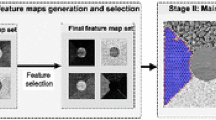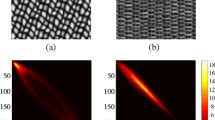Abstract
In this paper, a novel approach to texture segmentation based on the parametric active contour model (ACM) is proposed. At first, gray-level co-occurrence matrix and subsequently co-occurrence energy of the regions inside and outside of the dynamic contour are calculated. Difference of this energy corresponding to both the regions is used as the external energy of the proposed ACM. The contour stops and converges completely when this difference attains a maximum value. The proposed approach requires only initial contour selection and no object point selection like the other variants of parametric ACM used for texture segmentation. Experiments on a number of synthetic and real-world texture images show that in all cases, we are getting a better segmentation of the object although for few cases the execution time is bit more than that of other existing methods.






Similar content being viewed by others
References
Karasev, P., Kolesov, I., et al.: Interactive medical image segmentation using PDE control of active contours. IEEE Trans. Med. Imaging 32(11), 2127–2139 (2013)
Liu, G., Sun, X., et al.: Interactive geospatial object extraction in high resolution remote sensing images using shape-based global minimization active contour model. Pattern Recognit. Lett. 34(10), 1186–1195 (2013)
Tatu, A., Bansal, S.: A novel active contour model for texture segmentation. In: International Workshop on Energy Minimization Methods in Computer Vision and Pattern Recognition, Springer (2015)
Cimpoi, M., Maji, S., Vedaldi, A.: Deep filter banks for texture recognition and segmentation. In: Proceedings of the IEEE Conference on Computer Vision and Pattern Recognition (2015)
Andrearczyk, V., Whelan, P.F.: Texture segmentation with fully convolutional networks. arXiv preprint arXiv:1703.05230 (2017)
Kass, M., Witkin, A., et al.: Snakes: active contour models. Int. J. Comput. Vis. 1(4), 321–331 (1988)
Xu, C., Prince, J.L.: Snakes, shapes, and gradient vector flow. IEEE Trans. Image Process. 7(3), 359–369 (1998)
Li, B., Acton, S.T.: Active contour external force using vector field convolution for image segmentation. IEEE Trans. Image Process. 16(8), 2096–2106 (2007)
Caselles, V., Kimmel, R., et al.: Geodesic active contours. Int. J. Comput. Vis. 22(1), 61–79 (1997)
Chan, T.F., Vese, L.A.: Active contours without edges. IEEE Trans. Image Process. 10(2), 266–277 (2001)
Houhou, N., Thiran, J.-P.,et al.: Fast texture segmentation model based on the shape operator and active contour. In: IEEE Conference on Computer Vision and Pattern Recognition, CVPR (2008)
Paragios, N., Deriche, R.: Geodesic active regions and level set methods for supervised texture segmentation. Int. J. Comput. Vis. 46(3), 223–247 (2002)
Sagiv, C., Sochen, N.A., Zeevi, Y.Y.: Integrated active contours for texture segmentation. IEEE Trans. Image Process. 15(6), 1633–1646 (2006)
Qinggang, W., Gan, Y., Lin, B., Zhang, Q., Chang, H.: An active contour model based on fused texture features for image segmentation. Neurocomputing 151, 1133–1141 (2015)
Fergani, K., Lui, D.: Hybrid structural and texture distinctiveness vector field convolution for region segmentation. Comput. Vis. Image Underst. 125, 85–96 (2014)
Chan, D.-Y., et al.: Rectification-conducted adaptive snake for segmenting complex-boundary objects from textured backgrounds. Signal Image Video Process. 10(2), 225–234 (2016)
Vard, A.R., Moallem, P., et al.: Texture-based parametric active contour for target detection and tracking. Int. J. Imaging Syst. Technol. 19(3), 187–198 (2009)
Vard, A.R., Monadjemi, A., et al.: Fast texture energy based image segmentation using directional Walsh Hadamard transform and parametric active contour models. Expert Syst. Appl. 38(9), 11722–11729 (2011)
Moallem, P., Tahvilian, H., et al.: Parametric active contour model using Gabor balloon energy for texture segmentation. Signal Image Video Process. 10(2), 351–358 (2016)
Bigun, J.: Speed, frequency, and orientation tuned 3-d gabor filter banks and their design. In: Proceedings of the 12th IAPR International Conference Pattern Recognition, vol. 3-Conference C Signal Processing, pp. 184–187 (1994)
Materka, A., Strzelecki, M.: Texture analysis methods: a review, Technical University of Lodz, Institute of Electronics, COST B11 Report, Brussels, pp. 9–11 (1998)
Zhou, H., Zheng, J., Wei, L.: Texture aware image segmentation using graph cuts and active contours. Pattern Recognit. 46(6), 1719–1733 (2013)
Subudhi, P., Mukhopadhyay, S.: A fast texture segmentation scheme based on active contours and discrete cosine transform. Comput. Electr. Eng. 62, 105–118 (2017)
Subudhi, P., Mukhopadhyay, S.: A pyramidal approach to active contours implementation for 2D gray scale image segmentation. In: International Conference on Wireless Communications, Signal Processing and Networking (WiSPNET). IEEE (2016)
Author information
Authors and Affiliations
Corresponding author
Electronic supplementary material
Below is the link to the electronic supplementary material.
Rights and permissions
About this article
Cite this article
Subudhi, P., Mukhopadhyay, S. A novel texture segmentation method based on co-occurrence energy-driven parametric active contour model. SIViP 12, 669–676 (2018). https://doi.org/10.1007/s11760-017-1206-4
Received:
Revised:
Accepted:
Published:
Issue Date:
DOI: https://doi.org/10.1007/s11760-017-1206-4




